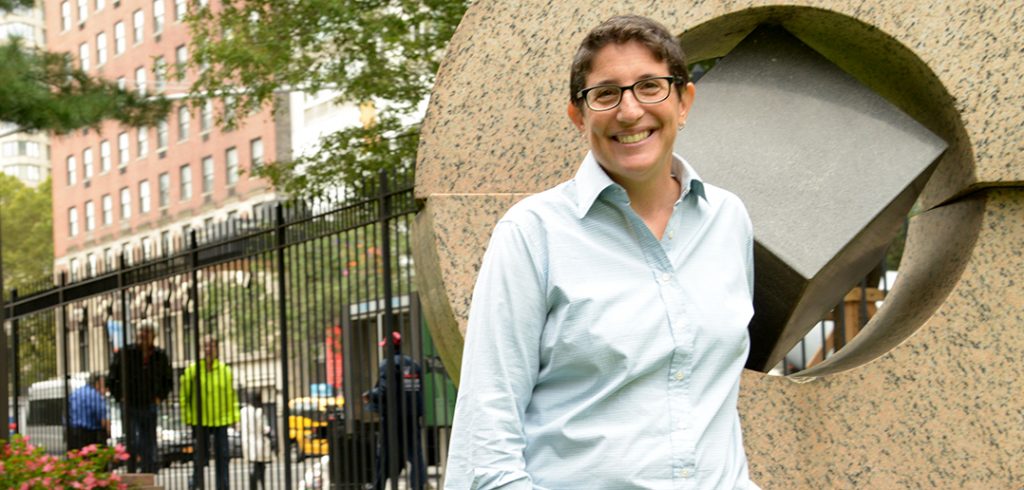At heart, Laura Wernick, Ph.D., assistant professor of social work, is an activist, scholar, and community organizer. She has worked with Jews for Racial and Economic Justice. She has studied the domestic workers movement.
And she has studied and written about an organizational model that helps wealthy, young activists get involved in causes they care about without wielding their considerable power. (The resulting research was published in Social Work Research this year.)
“I look at how people with power and privilege can get involved in social justice movement without replicating existing power structures, such as coming in and taking over, and thinking that they need to be the leader,” she said.
In Wernick’s work, everything from the initial questions to the presentation of the study’s findings to the use of the data to effect change is done in very close consultation with those being studied. The process is called community-based participatory action research.
“It places the power of research and knowledge in the hands of communities most impacted,” she said. “It’s a way to use research to bring people together to assess what they’ve collected and then use that knowledge as an organizing tool.”
Wernick’s research began to gel when she moved from New York City to Ann Arbor in 1998 to work on her doctoral degree at the University of Michigan. Once there, people who knew of her activist work contacted her to help a group of LGBTQ teens who were experiencing bullying in school. The teens had been part of a study before, but Wernick said that they had found the questions from the previous study irrelevant to their day-to-day lives.
This time, with Wernick, they would develop the questions.
The students were interested in creating a survey that addressed bullying, issues of heterosexual and cisgender normativity, and how the school’s emotional climate might affect homophobia and transphobia. They also wanted the survey to be about race and physical appearance.
Wernick obliged by working with the youth to create a questionnaire and organizing model that would ultimately cross multiple identities—race, class, gender, and religion to name a few.
To date, Wernick and the youth have co-authored and published eight papers on their project. The initial survey produced an article that was published in the Children and Youth Services Review in 2012.
Besides their activist interests, the teens became interested in the research process as well. “They wanted to understand what statistical significance meant, what bell curves were,” she said. “They learned how to use Stata, a statistical software, how to do T tests, and they understood what a regression model is. This is stuff that these kids became interested in!”
One student-participant became her research assistant; he is now earning his doctoral degree in sociology at the University of California at Santa Barbara. Another is working his law degree at Harvard.
But while there were clear educational benefits to the student-participants, it wasn’t the primary purpose of the study, she said.
After the first survey was completed, the students opted for an unconventional approach to distributing its findings. They used theater to spread the results. Wernick compared their effort to the Theater of the Oppressed—using theater as storytelling in order to promote social and political change.
Students wanted to present the play to their peers at the high school and middle school levels. But given the sensitive subject matter, Wernick said that they had to present it first to the school board, then the school district principals, and then teachers and social workers before finally getting to present it to their classmates. The process offered yet another opportunity to collect data, as each audience completed a survey about their attitudes towards the subject matter before and after the performance.
In one scene a student would act out walking down a hallway and hearing someone say, “That’s so gay.” The actor would then portray his inner feelings while another actor would deliver the cold hard data: 76 percent of gay students experience bullying and harassment.
Wernick said the process provided several points of data collection, furthering opportunities for the youth to reflect upon their actions and use the data in their ongoing work. The initial “climate survey” assessed the bullying, harassment, and microaggressions that LGBTQ youth were experiencing. A qualitative survey before and after the show assessed the impact that the study and the show had on the adult and student audiences, as well as the youth participants. Finally, another study LINK looked at the how the community action affected the students own sense of well- being (That paper, was published in Journal of Community Psychology, 2014).
Needless to say, attitudes shifted from before and after the performance. The results found their way into “Theater and Dialogue to Increase Youth’s Intentions to Advocate for LGBTQQ People,” published this year in Research on Social Work Practice.
“It was institutional change, organizational change, and personal change,” said Wernick, barely containing her excitement. “It was all these things!”


